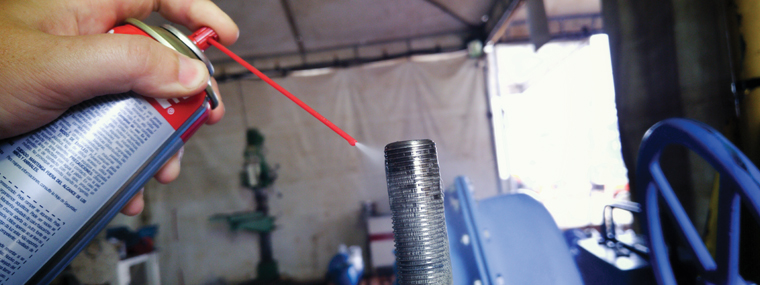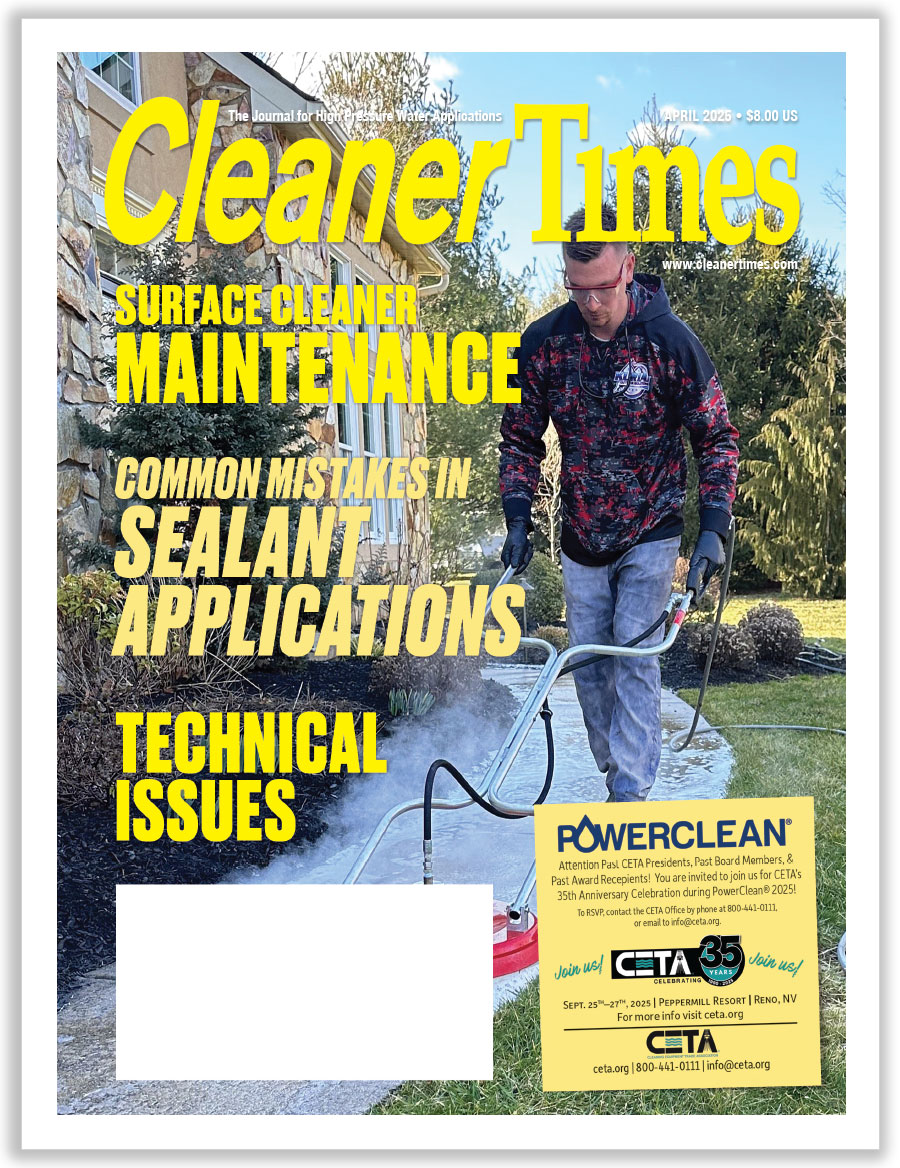
Role of Degreasers
By Diane M. Calabrese / Published April 2021

It’s the old grease or blood debate…Let’s skip it and agree each substance lacks charm and poses difficulties for contract cleaners.
Here, the focus is grease. It’s a fire hazard in kitchens (on surfaces and in ductwork). It’s a health and safety issue (slippery when not wet); everywhere it covers a substrate.
In the strict sense, grease derives directly from animal fat. But generically, grease is used to refer to lubricants, and removing it is a challenge whether it has an immediate organic source (animal fat, plant oil) or originates from a petroleum product or synthetic.
Ridding a floor, paved surface, engine, kitchen hood, and other surfaces of grease will require a degreaser. (Yes, there’s a move to find alternatives to the harshest chemicals used, and more about that in the last section.)
“Degreasers are a must for removing oil and grease,” says Eric Trice, owner of Absolute Pressure Cleaning in Hurlock, MD. “I work in the fleet-washing industry, so we use degreasers for several things.”
Trice gives us a couple of examples. “Our number two soap in our two-step wash process is a high pH alkaline detergent that is essentially a mild degreaser. This is used specifically to two-step trucks and help remove organic stains like soot, grease, bugs, etc.”
Then, there are the tougher jobs. “With garbage trucks, we will use a stronger degreaser to remove the garbage leachate from the canopies as well as heavy soot and grease on pivot points,” says Trice. “This degreaser is typically very strong; we like WD-25 from Southside Equipment [Brooks, KY] for things like this.”
The range of jobs dictates what’s required by a contractor, explains Trice. “As a general rule, you should always have a degreaser on hand for any oil or grease stain removal. For those in the fleet-washing industry, we need a variety of degreasers on hand for a variety of different applications.”
A single degreaser is not a fit for every surface. “We will treat a painted surface different than a concrete pad or even an asphalt road,” says Trice. “Solvent-based is good for certain baked-on oils.”
Sometimes a degreaser is not needed, explains Trice. “Just a higher concentration of truck soap goes a long way in many cases. Heat always helps but isn’t always required.”
A universal degreaser is not out there. Clarity of purpose requires matching degreaser (and cleaning product) to surface.
“No product I use is one-size-fits-all,” says Trice. “You see a lot of new truck-washing contractors using degreaser down the whole rig. That can damage paint and glass.”
Trice also cautions that contractors should know the risks tied to use (and incorrect use) of their products so as to avoid them. “A lot of people think that the acid or the number one [application] in the two-step process is the most dangerous, when in fact it’s the degreasers or the number-two soaps that we see cause the majority of damage to paint and windows.”
Must-Haves
Thick. Gross. Fat. Each one of those words is bound up in the Latin root word (crassus) of grease. (Crass and grease share the same root.) It’s another reminder of how unpleasant grease can be.
The amount of grease that goes down sinks and mucks up sewers eventually meets that flowing from pavement into waterways. The organic-rich sludge that accumulates is a challenge for wastewater treatment and water treatment plants alike.
Back up to the sources of grease—from kitchens to dumpsters to trucks—and realize the use of degreasers reduces the organic load on water supply system. That’s a big role for degreasers. (Read more about it in the last section.)
It may be a happy thought to commit to remove grease without using a product that contains a compound like sodium hydroxide, but it is less than a practical one. Degreasers are needed.
True, pressure washers or steam cleaners may be in use, but they are the intermediaries. “In many cleaning applications, the pressure washer or steam cleaner is simply the delivery method for the chemical/degreaser,” explains Jerry Meyer, vice president of Ben’s Cleaner Sales Inc. in Seattle, WA, “especially when cleaning oil- and grease-laden items. Chemicals/degreasers are a must for these where the pressure washer cannot do it alone.”
At the same time, Meyer reminds us there are misconceptions attached to the use of degreasers, and they should be corrected.
“That more is better” is one misplaced idea, says Meyer. “It’s easy to waste degreasers by using too much or using them too concentrated. Use them at the correct dilution per instructions.”
Take the time to apply them correctly to get good and cost-effective results. “Making chemicals/degreasers overly strong will not necessarily give you better results,” explains Meyer. “The extra chemical will simply increase your cost by wasting product that was not needed to get the job clean.”
Choose products carefully. “In most cases, low-cost chemicals end up costing more money,” says Meyer. “Use a quality product.”
There’s likely a difference in the product that’s tied to its cost. “Low-cost products are usually diluted down or have inferior chemical makeup,” says Meyer. “More concentrated, higher-quality products that cost more money up front will save money when being used to do the job—by using a chemical that cleans better and has a higher dilution ratio.”
Everyone is Interested
Kitchen-cleaning contractors may think of some of the less savory parts of their work, such as cleaning out the grease trap in a drain—where it’s possible rats have visited. And from dumpsters to drains, there are plenty of places where grease accumulates.
Truth is, though, wherever there are human hands at work, grease coatings follow. (The oil and protective secretions of our sebaceous glands are obvious on screens and keypads of our electronic devices.)
Worse, the same oily stuff can contaminate sensitive equipment in drug processing or medical instrument manufacturing lines. From the Food and Drug Administration (FDA) to the U.S. Department of Energy (DOE)—and to be sure, at the Environmental Protection Agency (EPA)—degreasers get a great deal of attention.
Parts-cleaning manufacturers in our industry serve clients with custom systems that clean and degrease. Solvent-cleaning machines and vapor-cleaning machines may stand alone or be in-line to remove soils from parts. The materials used as solvents or degreasers bring hazmat rules and often (depending on the state) air emissions rules into play.
Yet manufacturing electronic medical devices that are contaminant free and highly sensitive would not be possible without state-of-the-art cleaning. That cleaning includes chemicals. Vapor degreasing and ultrasonic cold cleaning are both used by medical device makers.
In the interest of clean air, clean water, and health (e.g., eliminating carcinogens), EPA encourages alternatives to some of the harshest degreasers. Trichloroethylene (TCE) used as a solvent in metal degreasing is one of many such chemicals.
Some companies have successfully replaced TCE in their processes. EPA gives the example of Danfoss Chatleff LLC in Buda, TX, a company that replaced a TCE-based degreaser with an aqueous degreaser/parts washer.
Citrus-based degreasers, baking soda paste, and kitty litter certainly have a place as substitutes for worrisome chemicals in some settings. But there’s a difference between cleaning a home kitchen countertop with a citrus-based product, or a car battery terminal with baking soda paste—and an industrial project. As for applying kitty litter or cornmeal to soak up grease/oil spots on the garage floor, it’s not a bad idea for a tiny spot.
The Office of Science and Technology Information (OSTI) at DOE reports routinely on the intense initiative at DOE to tie together the necessary and the practical. For instance, getting grease from animal and vegetable oils out of wastewater is just as important as removing remnants of petrochemical processes and lubricants.
Two points about DOE’s work are directly relevant to our industry:
One, physical treatment by gravity separation, dissolved air flotation, gas flotation, membrane processes—all of what those working with wastewater in our industry would expect—is an area of active research. So is chemical treatment, such as the addition of acid to floating oil emulsions (to break them up) followed by the addition of a neutralizer (e.g., lime) that produces coagulation, or degreasing by another name. The physical methods then remove the coagulates.
Two, the interest in using natural processes such as anaerobic bacteria to break up fat, oil, and grease is a vital area of investigation. (FOG is the acronym used for fat, oil, and grease collectively.)
Degreasers have an essential role to play in maximizing health and safety outcomes because they promote sanitation, streamline working parts, and tamp down fire hazards, just to name a few. Proper application of degreasers also reduces the amount of grease, oil, and fat that ultimately must be removed from wastewater reaching treatment plants.
With the foregoing in mind, our industry has a huge role to play and amplify. Reaching for a degreaser in a setting where it is the appropriate match is a very good thing to do, and the benefits should be weighed against any concerns with the use of degreasers.






